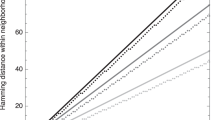Abstract.
This paper presents the exact analytical solution, valid for all generations and initial conditions, for the frequency distribution of haploids with infinite-sites genome carrying a given number of mutations in a population evolving deterministically on a truncated fitness landscape. This landscape is a generalization of the single sharp peak one, widely used in quasispecies theory, although here there are no reverse mutations.
Similar content being viewed by others
References
Alves, D., Fontanari, J.F.: A population genetics approach to the quasispecies model. Phys. Rev. E 54, 4048–4053 (1996) Available at http://arxiv.org/abs/cond-mat/9605160
Baake, E., Gabriel, W.: Biological evolution through mutation, selection, and drift: an introductory review. Ann. Rev. Comp. Phys. 9, In: D. Stauffer (ed.), World Scientific, 2000, pp. 203–264. Available at http://arxiv.org/abs/cond-mat/9907372
Charlesworth, B.: Mutation-selection balance and the evolutionary advantage of sex and recombination. Genet. Res. Camb. 55, 199–221 (1990)
Charlesworth, B., Sniegowski, P., Stephan, W.: The evolutionary dynamics of repetitive DNA in eukaryotes. Nature 371, 215–220 (1994)
Dawson, K.J.: The dynamics of infinitesimally rare alleles, applied to the evolution of mutation rates and the expression of deleterious mutations. Theor. Pop. Biol. 55, 1–22 (1999)
Domingo, E., Sabo, D., Taniguchi, T., Weissmann, C.: Nucleotide sequence heterogeneity of an RNA phage population. Cell 13, 735–744 (1978)
Eigen, M.: Selforganization of matter and the evolution of biological macromolecules. Naturwiss. 58, 465–523 (1971)
Eigen, M., McCaskill, J., Schuster, P.: Molecular quasi-species. J. Phys. Chem. 92, 6881–6891 (1988); The molecular quasi-species. Adv. Chem. Phys. 75, 149–263 (1989)
Graham, R.L., Knuth, D.E., Patashnik, O.: Concrete Mathematics - A Foundation for Computer Science Addison-Wesley, 1994, 2nd edition; http://www.mathpages.com/home/kmath464.htm
Hartl, D.L., Clark, A.G.: Principles of Population Genetics. Sinauer Associates Inc., Sunderland, 1989, 2nd edition
Johnson, T.: The approach to mutation-selection balance in an infinite asexual population, and the evolution of mutation rates. Proc. R. Soc. Lond. B 266 2389–2397 (1999); Theoretical Studies of the Interaction Between Deleterious and Beneficial Mutations (PhD thesis, University of Edinburgh 2000). Available at http://homepages.ed.ac.uk/ tobyj
Kimura, M., Maruyama, T.: The mutational load with epistatic gene interactions in fitness. Genetics 54, 1337–1351 (1966)
Maia, L.P., Botelho, D.F., Fontanari, J.F.: Analytical solution of the evolution dynamics on a multiplicative-fitness landscape. J. Math. Biol. 47, 453–456 (2003)
Martinez-Salas, E., Ortin, J., Domingo, E.: Sequence of the viral replicase gene from foot and mouth disease virus C1-Santa Pau (C-S8). Gene 35, 55–61 (1985)
Maynard Smith, J.: Models of evolution. Proc. R. Soc. Lond. B 219, 315–325 (1983)
Nowak, M., Schuster, P.: Error thresholds of replication in finite populations: mutation frequencies and the onset of Muller’s ratchet. J. Theor. Biol. 137, 375–395 (1989)
Ortin, J., Nájera, R., Lopez, C., Davila, M., Domingo, E.: Genetic variability of Hong Kong (H3N2) influenza viruses: spontaneous mutations and their location in the viral genome. Gene 11, 319–331 (1980)
Spiegelman, S., Haruna, I., Holland, I.B., Beaudreau, G., Mills, D.R.: The synthesis of a self-propagating and infectious nucleic acid with a purified enzyme. Proc. Natl. Acad. Sci. USA 54, 919–927 (1965)
Swetina, J., Schuster, P.: Self-replication with errors: a model for polynucleotide replication. Biophys. Chem. 16, 329–345 (1982)
Wagner, G.P., Krall, P.: What is the difference between models of error thresholds and Muller’s ratchet? J. Math. Biol. 32, 33–44 (1993)
Wiehe, T.: Model dependency of error thresholds: the role of fitness functions and contrasts between the finite and infinite sites models. Genet. Res. Camb. 69, 127–136 (1997)
Wilke, C.O., Ronnewinkel, C., Martinetz, T.: Dynamic fitness landscapes in molecular evolution. Phys. Rep. 349, 395–446 (2001). Available at http://arxiv.org/abs/physics/9912012
Author information
Authors and Affiliations
Corresponding author
Additional information
The author acknowledges J. F. Fontanari for critically reading the manuscript and the Brazilian agency FAPESP for financial support. This work was developed while the author was in the Instituto de Física de São Carlos, Universidade de São Paulo, Brazil.
Rights and permissions
About this article
Cite this article
Maia, L. The dynamical way to mutation-selection balance of an infinite population evolving on a truncated fitness landscape. J. Math. Biol. 51, 114–122 (2005). https://doi.org/10.1007/s00285-005-0327-5
Received:
Published:
Issue Date:
DOI: https://doi.org/10.1007/s00285-005-0327-5




